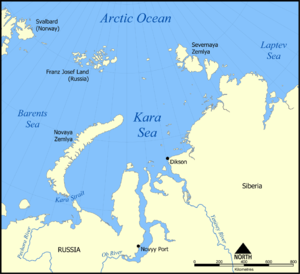
Cornelis Nay
Encyclopedia

Northern Sea Route
The Northern Sea Route is a shipping lane officially defined by Russian legislation from the Atlantic Ocean to the Pacific Ocean specifically running along the Russian Arctic coast from Murmansk on the Barents Sea, along Siberia, to the Bering Strait and Far East. The entire route lies in Arctic...
from Europe to the Far East.
Nay hailed from Enkhuizen
Enkhuizen
Enkhuizen is a municipality and a town in the Netherlands, in the province of North Holland and the region of West-Frisia.Enkhuizen was one of the harbour-towns of the VOC, just like Hoorn and Amsterdam, from where overseas trade with the East Indies was conducted. It received city rights in 1355...
in The Netherlands. In June of 1594, he set out from the Dutch island of Texel
Texel
Texel is a municipality and an island in the Netherlands, in the province of North Holland. It is the biggest and most populated of the Frisian Islands in the Wadden Sea, and also the westernmost of this archipelago, which extends to Denmark...
with a small fleet (consisting of three ships and a fishing boat) to discover the Northeast Passage
Northern Sea Route
The Northern Sea Route is a shipping lane officially defined by Russian legislation from the Atlantic Ocean to the Pacific Ocean specifically running along the Russian Arctic coast from Murmansk on the Barents Sea, along Siberia, to the Bering Strait and Far East. The entire route lies in Arctic...
. Nay commanded the ship De Zwaan. Fellow explorer Willem Barentsz, who commanded another of the ships (as well as the fishing boat), followed the coast of Novaya Zemlya
Novaya Zemlya
Novaya Zemlya , also known in Dutch as Nova Zembla and in Norwegian as , is an archipelago in the Arctic Ocean in the north of Russia and the extreme northeast of Europe, the easternmost point of Europe lying at Cape Flissingsky on the northern island...
, but his progress was halted by the ice. Nay was more successful: he passed through the Kara Strait
Kara Strait
The Kara Strait or Kara Gates is a 56 km wide channel of water between the southern end of Novaya Zemlya and the northern tip of Vaygach Island...
(south of Novaya Zemlya
Novaya Zemlya
Novaya Zemlya , also known in Dutch as Nova Zembla and in Norwegian as , is an archipelago in the Arctic Ocean in the north of Russia and the extreme northeast of Europe, the easternmost point of Europe lying at Cape Flissingsky on the northern island...
) and reached the Kara Sea
Kara Sea
The Kara Sea is part of the Arctic Ocean north of Siberia. It is separated from the Barents Sea to the west by the Kara Strait and Novaya Zemlya, and the Laptev Sea to the east by the Severnaya Zemlya....
.
Nay's success led to a second expedition the following year (1595) with a larger fleet, consisting of seven ships. The expedition was under the command of Nay (something to which Barentz was strongly opposed). Having left too late in the season, the explorers were soon stopped by the ice. Barentz wanted to stop for the winter and continue in the spring, but Nay decided that the fleet should return home.
The Dutch government considered the expedition a total flop and refused to fund a new expedition. Nevertheless, a third attempt was made the next year, in 1596 - this time without Nay. This was the famed expedition in which Barentz and his men managed to survive the winter on Novaya Zemlya
Novaya Zemlya
Novaya Zemlya , also known in Dutch as Nova Zembla and in Norwegian as , is an archipelago in the Arctic Ocean in the north of Russia and the extreme northeast of Europe, the easternmost point of Europe lying at Cape Flissingsky on the northern island...
, although Barentz died on the way home.
Nay and Barentz failed to find the passage to the East by way of the Arctic Sea. Nevertheless, the Dutch journeys of exploration in the Arctic
Arctic
The Arctic is a region located at the northern-most part of the Earth. The Arctic consists of the Arctic Ocean and parts of Canada, Russia, Greenland, the United States, Norway, Sweden, Finland, and Iceland. The Arctic region consists of a vast, ice-covered ocean, surrounded by treeless permafrost...
paved the way for large-scale whale and seal fishery which greatly enriched the Netherlands during the Dutch Golden Age
Dutch Golden Age
The Golden Age was a period in Dutch history, roughly spanning the 17th century, in which Dutch trade, science, military and art were among the most acclaimed in the world. The first half is characterised by the Eighty Years' War till 1648...
.

